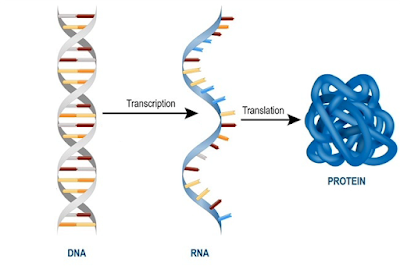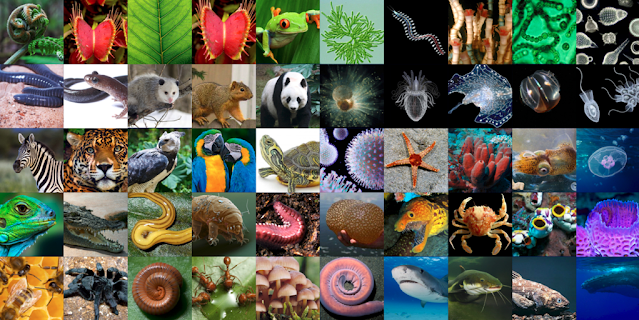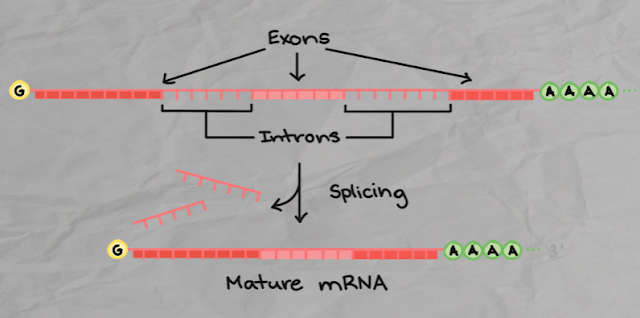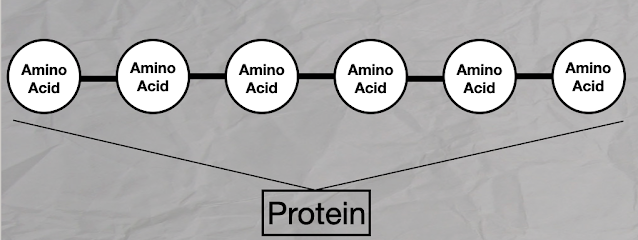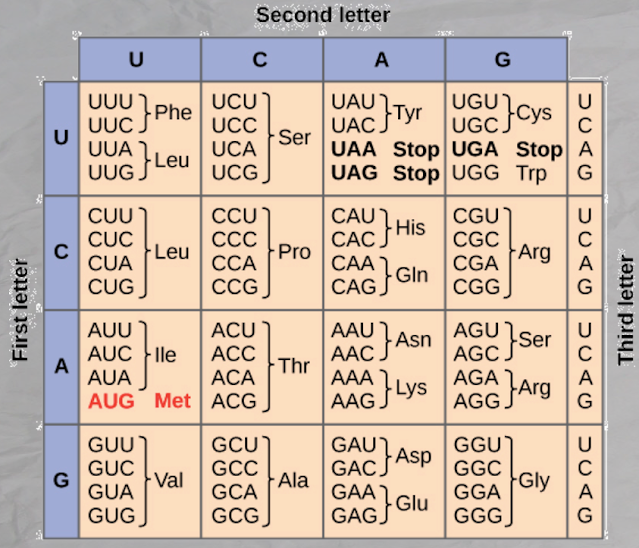Biology Index
Where are we going with this? The information on this page should increase understanding related to this standard: Demonstrate how DNA sequence information is decoded through transcriptional and translational processes within the cell in order to synthesize proteins. Examine the relationship of structure and function of various types of RNA and the importance of this relationship in these processes.
Article includes ideas, images, and content from Troy Smigielski (2022-01)
Protein Synthesis: Transcription
(So, this seems like a thing…)
The goal of protein synthesis is to make a protein. In other places, we have discussed that proteins do a wide variety of functions in the body and/or are expressed as a trait.
Therefore, as an organism grows, it is necessary to synthesize proteins—to make them within the cell. But, they have to be EXACTLY as designed.
How does this happen?
Keep in mind that proteins are complex.
Protein Review
Proteins are made up of amino acids sequenced together in a chain.
Thus, the monomer of proteins are amino acids.
 |
This is kinesin, a motor protein, thought
to be carrying an endorphin. |
An amino acid is… complicated…
Amino acids consist of a basic amino group (―NH2), an acidic carboxyl group (―COOH), and an organic R group (or side chain) that is unique to each amino acid. The term amino acid is short for α-amino [alpha-amino] carboxylic acid. Each molecule contains a central carbon (C) atom, called the α-carbon, to which both an amino and a carboxyl group are attached. The remaining two bonds of the α-carbon atom are generally satisfied by a hydrogen (H) atom and the R group (Source, 2021-09-01).
Amino acids are organic compounds that combine to form proteins (Source, 2021-09-01).
The general form of an amino acid looks like this.
There are 20 common amino acids used by all living things. In addition to proteins, amino acids form peptides and polypeptides, but… let's hold off on that for now.
Let's recap… before we press on…Proteins are made of amino acids.
Amino acids have four parts arranged around a central carbon. Carbon has 4 places stuff can bond to it.
Part 1: One bond is usually just hydrogen (H).
Part 2: One bond is usually H2N, an amino group.
Part 3: One bond is the carboxylic acid group (usually written as -COOH or CO2H).
Part 4: The fourth bond is the "organic side chain" called the "-R Group"
How do amino acids differ from one another? Amino acids differ in their -R groups. There are 20 different -R groups, which allows for a wide variety of proteins. The -R group determines what amino acid it is.
So, there are 20 different amino acids, and they combine to form proteins (and peptides and poly peptides, but we're overlooking that, here).
You can think of a protein as a sentence. The amino acids are the letters. The letters form words (peptides) and phrases (poly peptides) to create the protein. But… there are only 20 different letters (amino acids).
The order in which the amino acids combine determines what protein is made.
So, how do we replicate these things? This has to be difficult!
Let's take a look at a process by means of an illustration!
Suppose a biology teacher who may or may not also coach soccer wanted to build a nightstand… but, he doesn't know how. Luckily, his friend has detailed instructions on how to build it.
The friend sends over a copy of the instructions. But… The biology teacher doesn't have tools or wood.
Since he's lazy, he send his wife to Home Depot with the instructions to pick up the materials I need. Being the great wife she is, she returns home with everything needed. Now he can get to work and make the nightstand.
So, does it work out?
Does it look exactly the same? Pretty much!
From analogy to reality…
- The ribosome wants to build a protein, but it doesn’t know how.
- Luckily, DNA in the nucleus has detailed instructions on how to build it.
- Those instructions get sent to the ribosome through mRNA.
- With the instructions, tRNA brings the building blocks (amino acids) to the builder (ribosome).
- The ribosome builds the protein according to the instructions (DNA).
That doesn't look too bad! Wow!
Looking Closer
There are a lot of moving parts in making a protein. There are 3 kinds of RNA involved in making a protein.
Messenger RNA (mRNA) carries a copy of the code for a protein from the nucleus to the ribosome. mRNA serves as a “runner” or a “messenger” between the nucleus (DNA) and the ribosome (protein factory).
Ribosomal RNA (rRNA) makes up ribosomes. Remember, ribosomes make proteins.
Transfer RNA (tRNA) transfers the appropriate amino acid to the ribosome so that a protein can be made.
Remember, proteins are made out of amino acids—long, complex chains of amino acids.
So, how does your body use those RNAs to make a protein? Before the RNAs can be used, the process actually starts with DNA.
DNA makes RNA in a process called transcription.
RNA makes proteins in a process called translation.
This is the central dogma of biology. All life revolves around this process.
Every organism on here depends on
Overviewing The Process
Step 1: Transcription
Get the instructions for how to build the protein.
Step 2: Translation
Get the building blocks and build the protein.
Looking In More Detail
Step 1: Transcription
REMEMBER: DNA is a code of instructions, but it cannot leave the nucleus because of the nuclear envelope. mRNA can leave the nucleus. How?
Nuclear pores!
Transcription is the process where DNA makes mRNA. This happens in the nucleus. Remember, DNA is stuck in there.
About the Coding Strand and the Template Strand…
DNA, being a double helix, is two stranded. One strand, called the Coding Strand. This strand is in the actual order that will eventually identify the protein being made.
The other strand, called the Template Strand, is the opposite nucleotide to the coding strand.
So, the mRNA connects to the Template Strand, and thus, becomes an exact copy of the DNA coding strand. The proteins are recognized by the code on THIS strand, which is a copy of the DNA coding strand. (But, there are charts and tables the use the DNA code to identify the protein, too.)
Next, (to be discussed elsewhere), tRNA comes along dragging the amino acid that corresponds to the code on the mRNA. But, that's jumping ahead…
Why Uracil instead of Thymine in RNA?
The short answer is that it is easier for a cell to make Uracil, but Thymine is more stable. (
Source, 2022)
Three steps…
- Initiation - the promoter sequence in the DNA lets the process know where to begin; it serves as a template for the mRNA.
- Elongation - mRNA nucleotides (bases) are added by RNA polymerase.
- Termination - mRNA synthesis stops at the terminator sequence, and the mRNA strand leaves the nucleus.
REMEMBER: mRNA is able to leave the nucleus but DNA is not.
About those promoter and terminator sequences…
The promoter sequence is a special sequence of nucleotides that indicate where to start the process to build a protein. The terminator sequence indicates where to stop. If we go back to the metaphor of proteins being a sentence with amino acids as the letters, you could think of the promoter sequence as the "shift key" to make a capital letter to begin the sentence and the terminator sequence could be thought of as a period to end the sentence.
After termination, the cell has successfully copied the code from DNA to mRNA and has left the nucleus. But, does anyone actually read all of the directions?
Maybe not!
Having successfully copied the code from DNA to mRNA, the mRNA then leaves the nucleus. At this point, the cell has this looooong strand of mRNA, but it does not need it all. What do you think happens next?
The cell edits the sequence so that it only has the necessary information that is specific to the protein being built.
The unnecessary bits of the mRNA that get cut out are called introns. Think: Introns are invasive. Introns are intruders!
The necessary sequences of the mRNA that are left in are called exons. Think: Exons are expressed. Exons are expected.
So, how about another picture!
Making Sense of RNA Code
At this point, you have your shortened sequence of mRNA. BUT it is still pretty long. What could you do to make it easier to read?
mRNA is read in base groups of 3, which help decode the instructions piece by piece. A sequence of 3 bases is called a codon. Each codon codes for an amino acid.
DO NOT FORGET: the mRNA codes for these amino acids.
And chaining the amino acids together results in a protein.
How do you figure out which amino acid the mRNA codon is coding for? Basically, it's just magic?
Each amino acid is identifiable by a particular codon. The codons are made up of 3 nucleotides, and there are 4 versions of the RNA nucleotide: A, U, G, and C.
So, AAA is a codon. AAU is a codon. AAG is a… you get the idea…
Plot twist! Some amino acids are coded by more than one codon. Naturally…
So… here's a chart. You can begin with any of the 4 nucleotides in the center, then work outward to find what amino acid is coded by the resulting codon.
Say you start with the A, then move out to the U, then out to the G, you get AUG, which is Methionine.
The only codon that codes for the START of protein synthesis is AUG. Methionine is the ALWAYS the first amino acid in ALL proteins! That sort of deserves a mnemonic!
AUG = Starts proteins. (School starts in August!) Nicely done!
If you look close, you'll find that there are three codons for "Stop": UGA, UAG and UAA.
And since there's always more than one way to do things, here's another matrix for charting codons to proteins…
How about a list? Sure!
Inverse RNA codon table
| Amino acid | RNA codons |
| | Amino acid | RNA codons |
|
|---|
| Ala, A | GCU, GCC, GCA, GCG | | Ile, I | AUU, AUC, AUA | |
|---|
| Arg, R | CGU, CGC, CGA, CGG; AGA, AGG |
| Leu, L | CUU, CUC, CUA, CUG; UUA, UUG |
|
|---|
| Asn, N | AAU, AAC | | Lys, K | AAA, AAG | |
|---|
| Asp, D | GAU, GAC | | Met, M | AUG |
|---|
| Asn or Asp, B | AAU, AAC; GAU, GAC | | Phe, F | UUU, UUC | |
|---|
| Cys, C | UGU, UGC | | Pro, P | CCU, CCC, CCA, CCG | |
|---|
| Gln, Q | CAA, CAG | | Ser, S | UCU, UCC, UCA, UCG; AGU, AGC | |
|---|
| Glu, E | GAA, GAG | | Thr, T | ACU, ACC, ACA, ACG | |
|---|
| Gln or Glu, Z | CAA, CAG; GAA, GAG | | Trp, W | UGG |
|---|
| Gly, G | GGU, GGC, GGA, GGG | | Tyr, Y | UAU, UAC | |
|---|
| His, H | CAU, CAC | | Val, V | GUU, GUC, GUA, GUG | |
|---|
| START | AUG | STOP | UAA, UGA, UAG |
|
|---|
Well… well… well… That's a lot of letters!
Okay, let's look at an example…
This sequence codes for the following protein:
REMEMBER:
- Each amino acid has a different -R group.
- The order of amino acids determines the protein.
It would seem as if we’re done because we know the amino acids needed to build the protein.
Translation is the process that will deliver these amino acids to the ribosome, and we will talk about that tomorrow.








































